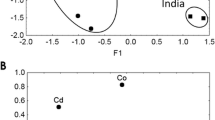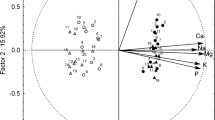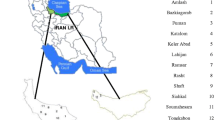Abstract
The metal contents of eleven black tea samples, four cultivated in Iran and seven imported, and their tea infusions were determined. Twelve elements consisting toxic metals (Al, As, Pb, Cr, Cd, and Ni) and essential mineral elements (Fe, Zn, Cu, Mn, Ca, and Mg) were analyzed using inductively coupled plasma atomic emission spectroscopy (ICP-AES). Al, Ca, Mg, and Mn ranged in black tea leaves at mg g−1 levels, while Cr, Fe, Ni, Cu, Zn were at µg g−1 levels. Analysis of variance showed no statistically significant differences among most elements determined in cultivated and imported black teas in Iran except for Ni and Cu. The extraction efficiency of each element into tea infusions was evaluated. The solubility of measured metals in infusion extracts varied widely and ranged from 0 to 59.3%. Among the studied elements, Cr, Pb, and Cd showed the lowest rates of solubility and Ni had the highest rates of solubility. The amount of toxic metals and essential mineral elements that one may take up through consumption of black tea infusion was estimated. The amount of realizing each element into tea infusions and acceptable daily intake, for safety consumption of black tea, was compared.
Similar content being viewed by others
Explore related subjects
Discover the latest articles, news and stories from top researchers in related subjects.Avoid common mistakes on your manuscript.
Introduction
Tea is one of the most popular beverages in the world, which is prepared from the leaves of a shrub Camellia sinensis. Tea contains flavonoids, minerals, and trace elements that are essential to human health. There have been various general surveys of the work on the medicinal value and beneficial health effects of tea consumption that has taken place in recent years [1, 2]. Some of the possible beneficial effects of drinking tea are: antioxidative activity [3], immune system boosting [4], protective effect against a range of cancers including lung, prostate, and breast cancer [5–7] and reduction of blood cholesterol levels [8].
The knowledge of both micronutrients and toxic elements content in beverages is important, taking into account nutrition requirement and intoxication risk related with their consumption. It should be stressed that the amount of an element, which can be retained in the organism, depends on the following parameters: total element content in tea leaves, fraction of the total content extracted to the infusion, and bioavailability of the element species present in the infusion.
Due to the importance of minerals in tea, several studies including atomic absorption spectroscopy (AAS) [9], inductively coupled plasma atomic emission spectrometry (ICP-AES) [10], inductively coupled plasma mass spectrometry (ICP-MS) [11], capillary electrophoresis [12], and total reflection X-ray fluorescence spectrometry (TR-XRF) [13] have been carried out in order to determine their levels in tea leaves and infusions.
Iran is a tea-producing country that relies on substantive imports to supplement its production to satisfy its considerable consumption needs. Iranians have one of the highest per capita rates of tea consumption in the world (1.6 kg per capita consumption in the period 2005–2007).
This article intends to provide information about the content of the essential and toxic trace elements in this beverage. Therefore, iron, manganese, copper, zinc, calcium, magnesium (as essential trace elements) aluminum, arsenic, lead, chromium, cadmium, and nickel (as potentially toxic elements) were determined in the dried leaves and infusions of black teas available in Iran.
Experimental
Materials
ICP-AES standard stock solutions of Al, Mg, Ca, Mn, Zn, Fe, Pb, Cd, Cr, Ni, Cu, and As at a concentration of 1,000 mg L−1 were obtained from Merck (Darmstadt, Germany), and working solutions were prepared by dilution of stock solutions in 5% (v/v) HNO3 immediately before use. Purified water obtained from a Milli-Q System (Millipore, Milford, MA, USA) was used for standard dilutions and other necessary preparations. All chemicals and reagents employed were of analytical grade.
Instrumentation
A Perkin Elmer model Optima 2100DV ICP-AES (Norwalk, CT, USA) was used for determination of selected elements in black tea leaves and their infusions. The operation conditions are listed in Table 1. These conditions were established after optimization of the instrumental parameters.
Sample Preparation
Eleven commercial black teas were purchased at the local markets in Tehran, Iran. The collected black tea brands were Nushineh, Bahar lahijan, Langar shomal, and Golestan cultivated in Iran (northern part of the country, Gilan province), Jahan, Golabi, and Darjeeling imported from India and Shahrzad, Chakoshe sabz, Tala, and Silan Golestan imported from Ceylon.
For each sample, about 1 g of ground tea sample was accurately weighed in a glass beaker, after adding 5 ml concentrated nitric acid, the samples were kept standing overnight at room temperature for predigestion. The samples were heated on a hot plate (80°C, 30 min), cooled down, and 1 ml concentrated nitric acid and 4 ml concentrated perchloric acid mixture were added. The digestion was carried out for about 1 h at 130°C until the solutions became transparent. After cooling to room temperature, the solutions were filtered into 25-mL volumetric flask and diluted. The solutions were subsequently analyzed for selected metals using ICP-AES.
Tea infusions were prepared by adding 45 ml of hot distilled water to 1 g black tea particles (or tea leaves from a tea bag). After five minutes of infusion, the solution was filtered (or the tea bag was taken out). When the solution reached room temperature, 1 mL concentrated nitric acid and appropriate amount of distilled water was added in a volumetric flask to make up a 50-mL volume.
Statistical Analysis
In order to verify differences among the mineral content of the varieties of studied tea samples, one factor analysis of variance was applied with the level of significance set at 0.05. The SPSS statistical program (SPSS Inc, IL, USA) was used to perform all statistical calculations.
Method Validation
For all elements, calibration was performed using aqueous standard solutions. To evaluate the analytical characteristics of the method for each element, the detection limits were calculated according to IUPAC rules [14].
The precision of method was evaluated in ten replicate determinations on each of five different randomly chosen samples. The reliability of the method was confirmed by using a certified reference material (National Bureau of Standard SRM 1571, Orchard Leaves).
Result and Discussion
The precision (as relative standard deviation, RSD), detection limits (µg g−1) and analytical wavelength (nm) are presented in Table 2. The results showed a good precision under the analytical conditions used since the relative standard deviations are lower than 10%. In order to verify the accuracy and analytical performance of the method, a certified reference material was used to determination of selected elements and the results are given in Table 3. The paired t test showed good agreement (p > 0.05) between the certified values and the obtained values.
The contents of toxic and essential elements of the black tea leaves and their infusions that determined in this study are summarized in Tables 4 and 5, respectively.
Aluminum, calcium, magnesium, and manganese are present in tea leaves at mg g−1 level, while chromium, iron, nickel, copper, and zinc are present at µg g−1 level [15]. In this work, Ca (3,454 to 5,891 µg g−1), Mg (1,540 to 2,716 µg g−1), and Al (584 to 1,546 µg g−1) had the highest concentration in black tea leaves, respectively. As shown by other authors [16], the most abundant heavy metal in tea leaves was Mn which, in the present study, ranged from 362 to 674 µg g−1. The total contents of other heavy metals determined in tea leaves arranged in the following order: Fe (105 to 407 µg g−1), Cu (19.84 to 58.48 µg g−1), and Zn (21.2 to 33.12 µg g−1). It should be noted that the concentrations of some toxic heavy metal such as As and Cd in black teas and their infusions were too low to be detected using the available analytical technique.
Many factors may be contributing to the metals accumulation in the tea leaves, such as soil [17], its organic matter contents [18], manufacturing process [10] and environmental pollutions. It was confirmed that the content of metals might be an adequate discriminator of tea varieties and their geographical origin [19].
Figure 1 shows the mean concentration in milligrams per gram (Fig.1a) and micrograms per gram (Fig.1b) of studied metals in black tea samples imported and cultivated in Iran.
One factor analysis of variance (ANOVA) of the data showed no statistically significant differences in mean contents of most determined element among the different black tea samples (p > 0.05). By performing the t test, the mean content of nickel and copper in cultivated black teas is significantly higher than imported black teas (p < 0.05).
The factor affecting the metal contents in tea leaves influence subsequently the metal concentrations in tea infusions. It has been recognized that the amount of trace elements extracted into the tea infusions depends principally on whether the compound is strongly bound to the matrix or more soluble in the solution employed [20]. Therefore, the amount of minerals in tea infusion depends on extraction efficiencies and total concentration of metal in tea leaves. According to extraction efficiencies from black tea leaves, Natesan and Ranganathan [21], classified analyte elements into three groups: highly extractable element (>55%), e.g., Ni, moderately extractable elements (22–55%), e.g., Mn, Mg, Al, Zn, and Cu and poorly extractable elements (<20%), e.g., Fe and Ca.
The extraction efficiency or realizing of each element was estimated as the ratio of its concentration in tea infusions to total concentration in black tea leaves. Table 6 presented mean percentage of realized minerals in black tea infusions and average daily intake of each element for black tea samples. The results showed that the concentration values of Mn for all samples were the highest concentration values and the concentration levels of Cu and Fe were the lowest concentration values among the essential heavy metals in tea infusions. Toxic heavy metals such as Cd and Pb are poorly extractable elements, therefore, the concentrations of these elements in tea infusions were below the detection limit of the proposed method.
With 1.6 kg per capita consumption of black tea leaves annually, Iranian daily consumption averages 4.3835 g of black tea leaves per person. Average daily intake of elements for black tea infusions consumption for Iranian was estimated (Table 6), for both cultivated and imported black teas.
Table 7 represents the allowable or acceptable daily intake (ADI) of toxic metals and reference or recommended daily intake (RDI) of essential minerals [22]. Average daily intake of Al and Ni by consumption of black tea infusions was low rather than ADI. Content of other potentially toxic elements such as: Pb, As, Cd, and Cr were below the detection limits of our instrument (ICP-AES), therefore, a more sensitive instrument, e.g., ICP-MS or preconcentration methods must be used for determination of these elements in tea infusions.
Conclusion
Twelve elements consisting potentially toxic metals (Al, As, Pb, Cr, Cd, and Ni) and essential mineral elements (Fe, Zn, Cu, Mn, Ca, and Mg) were analyzed in eleven black tea samples using ICP-AES. The reported levels for toxic and essential mineral elements in the black tea samples in present study were in agree with other studies. Tea is potentially a rich source of some dietary metals such as manganese. With widespread consumption of tea in the world, for many people, tea drinking may be a major source of dietary of essential elements.
With respect to acceptable daily intake of Al and Ni as toxic elements in daily dietary and safety standards, the infusion of black tea samples analyzed in the present study were found to be safe for human consumption. However, for other toxic metals, because of their low content, judgment about safety needs equipment that are more sensitive.
References
Dufresne CJ, Farnworth ER (2001) A review of latest research findings on the health promotion properties of tea. J Nutr Biochem 12:404–421
Weisburger JH (1997) Tea and health: a historical perspective. Cancer Lett 114:315–317
Luczaj W, Skrzydlewska E (2005) Anti-oxidative properties of black tea. Prev Med 40:910–918
Mark H (2007) The beneficial effects of tea on immune function and inflammation: a review of evidence from in vitro, animal, and human research. Nutr Res 27:373–379
Siddiqui IA, Raisuddin S, Shukla Y (2005) Protective effects of black tea extract on testosterone induced oxidative damage in prostate. Cancer Lett 227:125–132
Way T, Lee H, Kao M, Lin J (2004) Black tea polyphenol theaflavins inhibit aromatase activity and attenuate tamoxifen resistance in HER2/neu-transfected human breast cancer cells through tyrosine kinase suppression. Eur J Cancer 40:2165–2174
Record IR, Dreosti IE (1998) Protection by black tea and green tea against UVB and UVA + B induced skin cancer in hairless mice. Mutat Res 422:191–199
Fujita H, Yamagami T (2008) Antihypercholesterolemic effect of Chinese black tea extract in human subjects with borderline hypercholesterolemia. Nutr Res 28:450–456
Seenivasan S, Manikandan N, Muraleedharan NN, Selvasundaram R (2007) Heavy metal content of black teas from south India. Food Control 19:746–749
Fernandez PL, Pablos F, Martin MJ, Gonzalez AG (2002) Multi-element analysis of tea beverages by inductively coupled plasma atomic emission spectrometry. Food Chem 76:483–489
Matsuura H, Hokura A, Katsuki F, Itoh A, Haraguchi H (2001) Multi-element determination and speciation of major-to-trace elements in black tea leaves by ICP-AES and ICP-MS with the aid of size exclusion chromatography. Anal Sci 17:391–398
Feng H, Wang T, Yau SF (2003) Sensitive determination of trace-metal elements in tea with capillary electrophoresis by using chelating agent 4-(2-pyridylazo) resorcinol (PAR). Food Chem 81:607–611
Xie M, Vonbohlen A, Klocckenkamper R, Jian X, Guntherk K (1998) Multielement analysis of Chinese tea (Camellia sinensis) by total-reflection X-ray fluorescence. Eur Food Res 207:31–38
Long GL, Winefordner JD (1983) Limit of detection: a closer look at the IUPAC definition. Anal Chem 55:713A–724A
Cao X, Zhao G, Yin M, Li J (1998) Determination of ultra trace rare earth elements by inductively coupled plasma mass spectrometry with microwave digestion and AG50W-x8 cation exchange chromatography. Analyst 123:1115–1119
Zhang M, Fang L (2007) Tea plantation-induced activation of soil heavy metals. Comm Soil Sci Plant Anal 38:1467–1478
Özcan M (2005) Determination of mineral contents of Turkish herbal tea (Salvia aucheri var. canescens) at different infusion periods. J Med Food 8:110–112
Powell JJ, Burden TJ, Thompson RP (1998) In vitro mineral availability from digested tea: a rich dietary source of manganese. Analyst 123:1721–1724
Fernandez-Caceres P, Martin MJ, Pablos M, Gonzalez AG (2001) Differentation of tea (Camellia sinensis) varietes and their geographical origin according to their metal content. J Agric Food Chem 49:4775–4779
Costa LM, Gouveia ST, Nóbrega JA (2002) Comparison of heating extraction procedures for Al, Ca, Mg and Mn in tea samples. Anal Sci 18:313–318
Natesan S, Ranganathan V (1990) Content of various elements in different parts of the tea plant and in infusion of black tea from South India. J Agric Food Chem 51:125–139
Food and Nutrition Information Center, Dietary Guidance/Dietary Reference Intakes/DRI Tables, Dietary Reference Intakes: Elements, http://www.iom.edu/Object.File/Master/7/294/0.pdf
Author information
Authors and Affiliations
Corresponding author
Rights and permissions
About this article
Cite this article
Salahinejad, M., Aflaki, F. Toxic and Essential Mineral Elements Content of Black Tea Leaves and Their Tea Infusions Consumed in Iran. Biol Trace Elem Res 134, 109–117 (2010). https://doi.org/10.1007/s12011-009-8449-z
Received:
Accepted:
Published:
Issue Date:
DOI: https://doi.org/10.1007/s12011-009-8449-z





